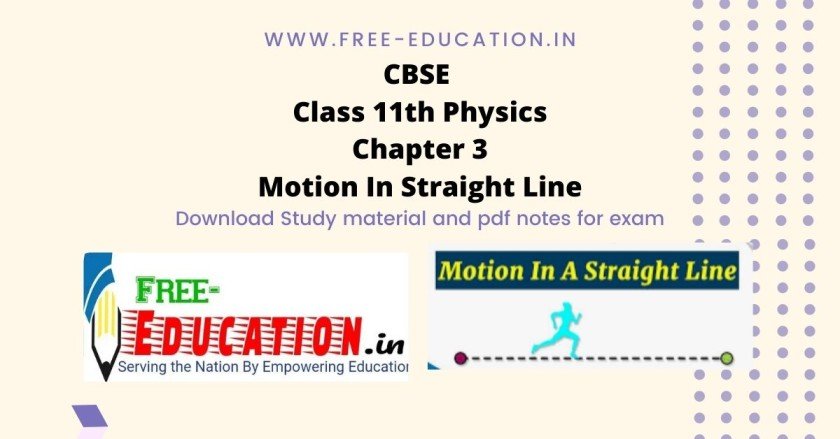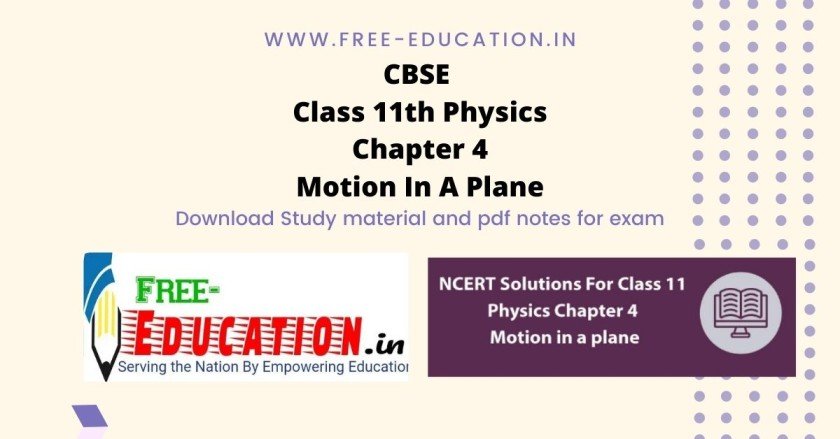www.free-education.in is a platform where you can get pdf notes from 6th to 12th class notes, General Knowledge post, Engineering post, Career Guidelines , English Speaking Trick , How to crack interview and lots more. ( Class 11 Physics Motion In A Straight Line )
NCERT Solutions for Class 11 Physics Chapter 3 Motion In Straight Line (Click Here)
| Section Name | Topic Name |
| 3 | Motion in a Straight Line |
| 3.1 | Introduction |
| 3.2 | Position, path length and displacement |
| 3.3 | Average velocity and average speed |
| 3.4 | Instantaneous velocity and speed |
| 3.5 | Acceleration |
| 3.6 | Kinematic equations for uniformly accelerated motion |
| 3.7 | Relative velocity |
Class 11 Physics Motion In A Straight Line Notes
Motion
Motion is change in position of an object with time.Motion of object along a straight line is called rectilinear motion. Examples include flying kite, moving train, earth’s rotation etc.

Frame of Reference
In order to know the change in position of an object, a reference point is required. Point O in the figure is the reference point or Origin and together with three axes, this system is called the coordinate system. A coordinate system with time frame is called frame of reference.
- Objects changing positions with time with respect to the frame of reference are in motion while those which do not change position are at rest.
- For a moving car, for the frame of reference outside the car, it appears moving. While for the frame of reference inside the car, the car appears stationary.


Path Length (Distance) Vs. Displacement
Path Length: It is the distance between two points along a straight line. It is scalar quantity.
Displacement: It is the change in position in a particular time interval. It is vector quantity. Change is position is usually denoted by Δx (x2-x1) and change in time is denoted by Δt (t2-t1).

Position-Time, Velocity-Time and Acceleration-Time Graph
| Criteria | P-T Graph | V-T Graph | A-T Graph |
| X and Y axis | Time and Position | Time and Velocity | Time and Acceleration |
| Slope | It represents velocity of an object | It represents acceleration of an object. | It represents the jerk or push of a moving object. |
| Straight slope | Uniform velocity | Uniform acceleration | Uniform jerk |
| Curvy Slope | Change in velocity | Change in acceleration | Change in the amount of push/jerk |


Average Velocity and Average Speed
| Criteria | Average Velocity | Average Speed |
| Definition | Change in position or displacement divided by time interval. | Total path length travelled divided by total time interval regardless of direction. |
| Formula | Avg speed = Total path length/Total time interval | |
| Scalar or Vector | Vector | Scalar |
| Sign | Can be positive or negative | Always positive |
| Unit | m/s | m/s |


Instantaneous Velocity and Instantaneous Speed
Instantaneous velocity describes how fast an object is moving at different instants of time in a given time interval. It is also defined as average velocity for an infinitely small time interval.

Here lim is taking operation of taking limit with time tending towards 0 or infinitely small.
dx/dt is differential coefficient – Rate of change of position with respect to time at an instant.






Relative Velocity
This is the velocity of an object relative to some other object which might be stationary, moving slowly, moving with same velocity, moving with higher velocity or moving in opposite direction.
If initial position of two objects A and B are xA (0) and xB (0), the position at time t will be,
- xA (t) = xA (0) + vA t
- xB (t) = xB (0) + vB t
- Displacement from object A to B, [ xB (0) – xA (0) ] + (vB -vA)t
- Velocity of B relative to A = vBA = vB – vA
- Velocity of A relative to B = vAB = vA – vB


Related link you must like:-
Study material for Competition Exam
Mohd. Sharif Qualification: B.Tech (Mechanical Engineering) [Founder of Wisdom Academy] [Aim Foundation & Free-Education.In] [Engineer By Profession | Teacher By Choice] [Blogger, YouTube Creator]






